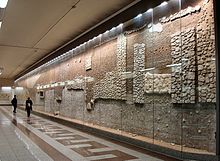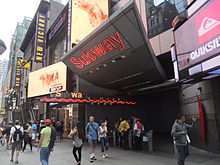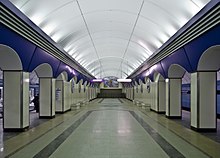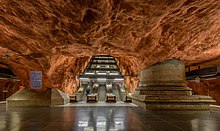| Revision as of 18:49, 1 November 2023 edit2a02:a452:7ddc:1:18e7:3267:922c:cca2 (talk)No edit summary← Previous edit | Revision as of 08:18, 8 December 2023 edit undoCitation bot (talk | contribs)Bots5,429,486 edits Alter: title. | Use this bot. Report bugs. | Suggested by BOZ | Category:Articles with bare URLs for citations from May 2022 | #UCB_Category 37/928Next edit → | ||
| Line 106: | Line 106: | ||
| *The largest and most complex metro station is the ]-] station ] in France, with 20 platforms serving eight (three ] ] and five ]) lines.<ref>{{Cite web |title=Réaménagement du pôle RER Chatelet-les-Halles |url=http://www.ratp.fr/common/ressources/concertation_p1.pdf |url-status=dead |archive-url=https://web.archive.org/web/20080307170412/http://www.ratp.fr/common/ressources/concertation_p1.pdf |archive-date=2008-03-07 |access-date=2008-03-13 |language=fr}}</ref> | *The largest and most complex metro station is the ]-] station ] in France, with 20 platforms serving eight (three ] ] and five ]) lines.<ref>{{Cite web |title=Réaménagement du pôle RER Chatelet-les-Halles |url=http://www.ratp.fr/common/ressources/concertation_p1.pdf |url-status=dead |archive-url=https://web.archive.org/web/20080307170412/http://www.ratp.fr/common/ressources/concertation_p1.pdf |archive-date=2008-03-07 |access-date=2008-03-13 |language=fr}}</ref> | ||
| *The deepest metro station is ]'s ] located in China, the top of rail of the station's ] tracks is 106 meters (347 feet 9 inches) deep,<ref>{{Cite web|title=全国最深地铁站红岩村站主体开挖初支完成|url=https://tunn.cscec.com/xwzx62/gskx62/202003/3053618.html|access-date=2022-02-03|author=中建隧道建设有限公司|date=2020-03-31}}</ref> and the deepest point is about 116 meters (380 feet 7 inches) underground.<ref>{{Cite web|title=重庆轨道交通9号线一期工程正式通车试运营|url=http://cq.news.cn/2022-01/25/c_1128300173.htm|access-date=2022-02-03|work=cq.news.cn}}</ref> | *The deepest metro station is ]'s ] located in China, the top of rail of the station's ] tracks is 106 meters (347 feet 9 inches) deep,<ref>{{Cite web|title=全国最深地铁站红岩村站主体开挖初支完成|url=https://tunn.cscec.com/xwzx62/gskx62/202003/3053618.html|access-date=2022-02-03|author=中建隧道建设有限公司|date=2020-03-31}}</ref> and the deepest point is about 116 meters (380 feet 7 inches) underground.<ref>{{Cite web|title=重庆轨道交通9号线一期工程正式通车试运营|url=http://cq.news.cn/2022-01/25/c_1128300173.htm|access-date=2022-02-03|work=cq.news.cn}}</ref> | ||
| *The highest ] station is ]'s ] at {{convert|48|m|ft}} above ground.<ref>{{Cite web |title=关于轨道交通9号线一期,你想知道的,都在这儿啦!_重庆市人民政府网 |url=https://www.cq.gov.cn/zwgk/zfxxgkml/hygq/202201/t20220125_10339096.html |access-date=2023-03-15 |website=www.cq.gov.cn}}</ref><ref>{{Cite web |title=重庆9号线一期开通 化龙桥站再现 |
*The highest ] station is ]'s ] at {{convert|48|m|ft}} above ground.<ref>{{Cite web |title=关于轨道交通9号线一期,你想知道的,都在这儿啦!_重庆市人民政府网 |url=https://www.cq.gov.cn/zwgk/zfxxgkml/hygq/202201/t20220125_10339096.html |access-date=2023-03-15 |website=www.cq.gov.cn}}</ref><ref>{{Cite web |title=重庆9号线一期开通 化龙桥站再现"轨道穿楼"-中国科技网 |url=http://www.stdaily.com/index/kejixinwen/202201/7bff78271f0e4b8eb898406da76290ea.shtml |access-date=2023-03-15 |website=www.stdaily.com}}</ref> | ||
| *The ] is the ] ] in Finland, at {{Coord|60|14|21|N|25|6|39|E|type:railwaystation|display=inline}}.<ref>{{Cite web |title=Mellunmäki The world's northernmost metro station, in Helsinki |url=http://finland.fi/?fact=16827 |url-status=dead |archive-url=https://web.archive.org/web/20180428141604/https://finland.fi/?fact=16827 |archive-date=28 April 2018 |access-date=28 April 2018 |website=finland.fi }}</ref> | *The ] is the ] ] in Finland, at {{Coord|60|14|21|N|25|6|39|E|type:railwaystation|display=inline}}.<ref>{{Cite web |title=Mellunmäki The world's northernmost metro station, in Helsinki |url=http://finland.fi/?fact=16827 |url-status=dead |archive-url=https://web.archive.org/web/20180428141604/https://finland.fi/?fact=16827 |archive-date=28 April 2018 |access-date=28 April 2018 |website=finland.fi }}</ref> | ||
| *The ] is the ]'s ] in Argentina, at {{coord|34|38|34.9|S|58|27|41.8|W|type:railwaystation|display=inline}}. | *The ] is the ]'s ] in Argentina, at {{coord|34|38|34.9|S|58|27|41.8|W|type:railwaystation|display=inline}}. | ||
Revision as of 08:18, 8 December 2023
Railway station of a rapid transit system For the American rock band, see Metro Station (band). "Underground station" redirects here. For a list of railway stations located underground, see Category:Railway stations located underground. For a list of London Underground stations, see List of London Underground stations.



A metro station or subway station is a train station for a rapid transit system, which as a whole is usually called a "metro" or "subway". A station provides a means for passengers to purchase tickets, board trains, and evacuate the system in the case of an emergency. In the United Kingdom, they are known as underground stations, most commonly used in reference to the London Underground.
Location
The location of a metro station is carefully planned to provide easy access to important urban facilities such as roads, commercial centres, major buildings and other transport nodes.
Most stations are located underground, with entrances/exits leading up to ground or street level. The bulk of the station is typically positioned under land reserved for public thoroughfares or parks. Placing the station underground reduces the outside area occupied by the station, allowing vehicles and pedestrians to continue using the ground-level area in a similar way as before the station's construction. This is especially important where the station is serving high-density urban precincts, where ground-level spaces are already heavily utilised.
In other cases, a station may be elevated above a road, or at ground level depending on the level of the train tracks. The physical, visual and economic impact of the station and its operations will be greater. Planners will often take metro lines or parts of lines at or above ground where urban density decreases, extending the system further for less cost. Metros are most commonly used in urban cities, with great populations. Alternatively, a preexisting railway land corridor is re-purposed for rapid transit.
Facilities

At street level the logo of the metro company marks the entrances/exits of the station. Usually, signage shows the name of the station and describes the facilities of the station and the system it serves. Often there are several entrances for one station, saving pedestrians from needing to cross a street and reducing crowding.
A metro station typically provides ticket vending and ticket validating systems. The station is divided into an unpaid zone connected to the street, and a paid zone connected to the train platforms. The ticket barrier allows passengers with valid tickets to pass between these zones. The barrier may be operated by staff or more typically with automated turnstiles or gates that open when a transit pass is scanned or detected. Some metro systems dispense with paid zones and validate tickets with staff in the train carriages.
Access from the street to ticketing and the train platform is provided by stairs, concourses, escalators, elevators and tunnels. The station will be designed to minimise overcrowding and improve flow, sometimes by designating tunnels as one way. Permanent or temporary barriers may be used to manage crowds. Some metro stations have direct connections to important nearby buildings (see underground city).
Most jurisdictions mandate that people with disabilities must have unassisted use of the station. This is resolved with elevators, taking a number of people from street level to the unpaid ticketing area, and then from the paid area to the platform. In addition, there will be stringent requirements for emergencies, with backup lighting, emergency exits and alarm systems installed and maintained. Stations are a critical part of the evacuation route for passengers escaping from a disabled or troubled train.
A subway station may provide additional facilities, such as toilets, kiosks and amenities for staff and security services, such as Transit police.
Transfer stations
Some metro stations are interchanges, serving to transfer passengers between lines or transport systems. The platforms may be multi-level. Transfer stations handle more passengers than regular stations, with additional connecting tunnels and larger concourses to reduce walking times and manage crowd flows.
Platform-edge doors
Further information: Platform screen doorsIn some stations, especially where trains are fully automated, the entire platform is screened from the track by a wall, typically of glass, with automatic platform-edge doors (PEDs). These open, like elevator doors, only when a train is stopped, and thus eliminate the hazard that a passenger will accidentally fall (or deliberately jump) onto the tracks and be run over or electrocuted.
Control over ventilation of the platform is also improved, allowing it to be heated or cooled without having to do the same for the tunnels. The doors add cost and complexity to the system, and trains may have to approach the station more slowly so they can stop in accurate alignment with them.
Architectural design
Metro stations, more so than railway and bus stations, often have a characteristic artistic design that can identify each stop. Some have sculptures or frescoes. For example, London's Baker Street station is adorned with tiles depicting Sherlock Holmes. The tunnel for Paris' Concorde station is decorated with tiles spelling the Déclaration des Droits de l'Homme et du Citoyen. Every metro station in Valencia, Spain has a different sculpture on the ticket-hall level. Alameda station is decorated with fragments of white tile, like the dominant style of the Ciutat de les Arts i les Ciències. Each of the original four stations in the Olympic Green on Line 8 of the Beijing Subway are decorated in Olympic styles, while the downtown stations are decorated traditionally with elements of Chinese culture. On the Tyne and Wear Metro, the station at Newcastle United's home ground St James' Park is decorated in the clubs famous black and white stripes. Each station of the Red Line and Purple Line subway in Los Angeles was built with different artwork and decorating schemes, such as murals, tile artwork and sculptural benches. Every station of the Mexico City Metro is prominently identified by a unique icon in addition to its name, because the city had high illiteracy rates at the time the system was designed.
Some metro systems, such as those of Naples, Stockholm, Moscow, St. Petersburg, Tashkent, Kyiv, Montreal, Lisbon, Kaohsiung and Prague are famous for their beautiful architecture and public art. The Paris Métro is famous for its art nouveau station entrances; while the Athens Metro is known for its display of archeological relics found during construction.
However, it is not always the case that metro designers strive to make all stations artistically unique. Sir Norman Foster's new system in Bilbao, Spain uses the same modern architecture at every station to make navigation easier for the passenger, though some may argue that this is at the expense of character.
Metro stations usually feature prominent poster and video advertising, especially at locations where people are waiting, producing an alternative revenue stream for the operator.
Construction types
| This section is missing information about elevated and at-grade station types. Please expand the section to include this information. Further details may exist on the talk page. (August 2023) |
Shallow column station

The shallow column station is a type of construction of subway stations, with the distinguishing feature being an abundance of supplementary supports for the underground cavity. Most designs employ metal columns or concrete and steel columns arranged in lines parallel to the long axis of the station.
Stations can be double-span with a single row of columns, triple-span with two rows of columns, or multi-span. The typical shallow column station in Russia is triple-span, assembled from concrete and steel, and is from 102 to 164 metres in length with a column spacing of 4–6 m. Along with the typical stations, there are also specially built stations. For example, one of the spans may be replaced with a monolithic vault (as in the Moskovskaya station of the Samara Metro or Sibirskaya of the Novosibirsk Metro). In some cases, one of the rows of columns may be replaced with a load-bearing wall. Such a dual hall, one-span station, Kashirskaya, was constructed to provide a convenient cross-platform transfer. Recently, stations have appeared with monolithic concrete and steel instead of assembled pieces, as Ploshchad Tukaya in Kazan.
The typical shallow column station has two vestibules at both ends of the station, most often combined with below-street crossings.
For many metro systems outside Russia, the typical column station is a two-span station with metal columns, as in New York City, Berlin, and others. In Chicago, underground stations of the Chicago 'L' are three-span stations if constructed with a centre platform.
In the Moscow Metro, approximately half of the stations are of shallow depth, built in the 1960s and 1970s, but in Saint Petersburg, because of the difficult soil conditions and dense building in the centre of the city this was impossible. The Saint Petersburg Metro has only five shallow-depth stations altogether, with three of them having the column design: Avtovo, Leninsky Prospekt, and Prospekt Veteranov. The first of these is less typical, as it is buried at a significant depth, and has only one surface vestibule.
Deep column station

A deep column station is a type of subway station consisting of a central hall with two side halls connected by ring-like passages between a row of columns. Depending on the type of station, the rings transmit load to the columns either by "wedged arches" or through Purlins, forming a "column-purlin complex".
The fundamental advantage of the column station is the significantly greater connection between the halls, compared with a pylon station.
The first deep column station in the world is Mayakovskaya, opened in 1938 in Moscow.
One variety of column station is the "column-wall station". In such stations, some of the spaces between the columns are replaced with walls. In this way, the resistance to earth pressure is improved in difficult ground environments. Examples of such stations in Moscow are Krestyanskaya Zastava and Dubrovka. In Saint Petersburg, Komendantsky Prospekt is an example.
Pylon station

The pylon station is a type of deep underground subway station. The basic distinguishing characteristic of the pylon station is the manner of division of the central hall from the station tunnels
The pylon station consists of three separate halls, separated from each other by a row of pylons with passages between them. The independence of the halls allows the architectural form of the central and side halls to be differentiated. This is especially characteristic in the non-metro Jerusalem–Yitzhak Navon railway station, constructed as a pylon station due to its 80-meter depth, where the platform halls are built to superficially resemble an outdoor train station.
Building stations of the pylon type is preferable in difficult geological situations, as such a station is better able to oppose earth pressure. However, the limited number of narrow passages limits the throughput between the halls.
The pylon station was the earliest type of deep underground station. One variation is the so-called London-style station. In such stations the central hall is reduced to the size of an anteroom, leading to the inclined walkway or elevators. In some cases the anteroom is also the base of the escalators. In the countries of the former USSR there is currently only one such station: Arsenalna in Kyiv. In Jerusalem, two planned underground heavy rail stations, Jerusalem–Central and Jerusalem–Khan, will be built this way. In Moscow, there were such stations, but they have since been rebuilt: Lubyanka and Chistiye Prudy are now ordinary pylon stations, and Paveletskaya-Radialnaya is now a column station.
In the Moscow Metro, typical pylon station are Kievskaya-Koltsevaya, Smolenskaya of the Arbatsko-Pokrovskaya line, Oktyabrskaya-Koltsevaya, and others.
In the Saint Petersburg Metro, pylon stations include Ploshchad Lenina, Pushkinskaya, Narvskaya, Gorkovskaya, Moskovskie Vorota, and others.
Single-vault station

The construction of a single-vault station consists of a single wide and high underground hall, in which there is only one vault (hence the name). The first single-vault stations were built in Leningrad in 1975: Politekhnicheskaya and Ploshchad Muzhestva. Not long after, the first two-level single-vault transfer stations were opened in Washington DC in 1976: L'Enfant Plaza, Metro Center and Gallery Place.
In the Moscow Metro there is only one deep underground single-vault station, Timiryazevskaya, in addition to several single-vault stations at shallow depth. In the Nizhny Novgorod Metro there are four such stations: Park Kultury, Leninskaya, Chkalovskaya and Kanavinskaya. In the Saint Petersburg Metro all single-vault stations are deep underground, for example Ozerki, Chornaya Rechka, Obukhovo, Chkalovskaya, and others. Most of the underground stations of the Washington, D.C.'s Metro system are single-vault designs, as are all the single-line vaulted stations in the Montreal Metro. In Prague Metro, there are two underground stations built as single-vault, Kobylisy and Petřiny.
Cavern station

| This section needs expansion. You can help by adding to it. (May 2022) |
The cavern station is a metro station built directly inside a cavern. Many stations of the Stockholm Metro, especially on the Blue Line, were built in man-made caverns; instead of being enclosed in a tunnel, these stations are built to expose the bedrock in which they are excavated. The Stockholm Metro also has a depot facility built in a cavern system.
In the Hong Kong MTR, examples of stations built into caverns include Tai Koo station on Hong Kong Island, Other examples in the city include Sai Wan Ho, Sai Ying Pun, Hong Kong University and Lei Tung stations.
Records
- The first and oldest extant underground station is Baker Street tube station which opened in 1863.
- The largest and most complex metro station is the Paris Métro-RER station Châtelet-Les Halles in France, with 20 platforms serving eight (three RER commuter rail and five Métro) lines.
- The deepest metro station is Chongqing Rail Transit's Hongyancun station located in China, the top of rail of the station's Line 9 tracks is 106 meters (347 feet 9 inches) deep, and the deepest point is about 116 meters (380 feet 7 inches) underground.
- The highest elevated station is Chongqing Rail Transit's Hualongqiao station at 48 metres (157 ft) above ground.
- The northernmost metro station is the Helsinki Metro's Mellunmäki station in Finland, at 60°14′21″N 25°6′39″E / 60.23917°N 25.11083°E / 60.23917; 25.11083.
- The southernmost metro station is the Buenos Aires Underground's Plaza de los Virreyes - Eva Perón metro station in Argentina, at 34°38′34.9″S 58°27′41.8″W / 34.643028°S 58.461611°W / -34.643028; -58.461611.
See also
- In a Station of the Metro (poem)
- List of metro systems
- Outline of transport
- Railway platform
- Rapid transit
References
- ^ Tumlin, Jeffrey (2012). Sustainable Transportation Planning: Tools for Creating Vibrant, Healthy, and Resilient Communities. Wiley. p. 118.
- ^ Edwards, Jack (1990). Civil Engineering for Underground Rail Transport. Butterworth & Co.
- "Landmarks in urban transport". Nexus. 2015. Archived from the original on 2016-03-24. Retrieved 2016-05-15.
- Benz, G.; et al. (1987). Rapid-rail transit and planning tools. National Research Council, Washington DC, Transportation Research Board.
- "Midland Metro Cash Fares". National Express. 2016. Archived from the original on 2016-05-26. Retrieved 2016-05-15.
- Xu, Xiaohui; Song, Bo; Li, Chunxia; Hu, Xujun (2010). "Study on the Safety and Disaster-Prevention Signing System of the Subway Based on Site Investigation at Home and Abroad" (PDF). University of Science and Technology Beijing, China. Archived from the original (PDF) on 2016-06-09. Retrieved 2016-05-15.
- "Metro Arts and Architecture". Metro Bits. Archived from the original on 2006-12-02. Retrieved 2006-12-04.
- "Subway Advertising". Blue Line Media. Archived from the original on 2016-05-03. Retrieved 2016-05-16.
- "Строительство станций мелкого заложения | Московское метро". nashemetro.ru. Retrieved 2021-04-13.
- "Строительство колонных станций | Московское метро". nashemetro.ru. Retrieved 2021-04-13.
- "Строительство пилонных станций | Московское метро". nashemetro.ru. Retrieved 2021-04-13.
- "Строительство односводчатых станций глубокого заложения | Московское метро". nashemetro.ru. Retrieved 2021-04-13.
- Morrison, Geoffrey. "Stockholm Metro: The Most Beautiful Subway In The World?". Forbes. Retrieved 2023-05-17.
- "Riding the Tunnelbana - the painted caves of the Stockholm Metro". I Ride The Harlem Line. 2015-09-18. Retrieved 2023-05-17.
- "Norsborg Metro Depot – Sweden Underground". Retrieved 2023-05-17.
- ^ "Cavern Development - 岩洞發展".
- "Dragages Hong Kong".
- Sharp, J. C.; Smith, M. C. F.; Thomas, I. M.; Turner, V. D. (1987). "Tai Koo Cavern, Hong Kong - Performance of a Large Metro Excavation in a Partially Weathered Rock Mass. Large Rock Caverns - Proceedings of the International Symposium, Helsinki, Finland, 25-28 August 1986. Volume 1". Publication of: Pergamon Press Limited.
- https://www.cavern.gov.hk/Sources/Panel%2520201408%2520-%2520cavern.pdf
- "Rock Caverns – Hong Kong's Hidden Land".
- "Réaménagement du pôle RER Chatelet-les-Halles" (PDF) (in French). Archived from the original (PDF) on 2008-03-07. Retrieved 2008-03-13.
- 中建隧道建设有限公司 (2020-03-31). "全国最深地铁站红岩村站主体开挖初支完成". Retrieved 2022-02-03.
- "重庆轨道交通9号线一期工程正式通车试运营". cq.news.cn. Retrieved 2022-02-03.
- "关于轨道交通9号线一期,你想知道的,都在这儿啦!_重庆市人民政府网". www.cq.gov.cn. Retrieved 2023-03-15.
- "重庆9号线一期开通 化龙桥站再现"轨道穿楼"-中国科技网". www.stdaily.com. Retrieved 2023-03-15.
- "Mellunmäki The world's northernmost metro station, in Helsinki". finland.fi. Archived from the original on 28 April 2018. Retrieved 28 April 2018.
External links
- UrbanRail.Net — descriptions of all metro systems in the world, each with a schematic map showing all stations.
| Public transport | |
|---|---|
| Bus service | |
| Rail | |
| Vehicles for hire | |
| Carpooling | |
| Ship | |
| Cable | |
| Other transport | |
| Locations | |
| Ticketing and fares |
|
| Routing | |
| Facilities | |
| Scheduling | |
| Politics | |
| Technology and signage | |
| Other topics | |